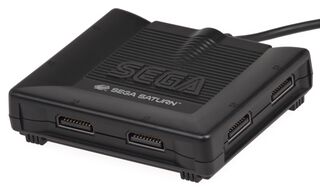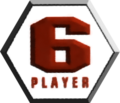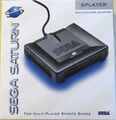Difference between revisions of "6Player"
From Sega Retro
m (Text replacement - "maker=Sega" to "maker=Sega Enterprises, Ltd.") |
|||
| (32 intermediate revisions by 6 users not shown) | |||
| Line 1: | Line 1: | ||
{{AccessoryBob | {{AccessoryBob | ||
| accessoryimage=Sega Saturn 6 Player Multiplayer Adapter.jpg | | accessoryimage=Sega Saturn 6 Player Multiplayer Adapter.jpg | ||
| − | |||
| − | |||
| title= | | title= | ||
| − | | maker=[[Sega]] | + | | maker=[[Sega Enterprises, Ltd.]] |
| + | | type=Multiplayer adapter | ||
| madefor=[[Sega Saturn]] | | madefor=[[Sega Saturn]] | ||
| releases={{releasesSat | | releases={{releasesSat | ||
| − | | sat_date_jp=1995-01 | + | | sat_date_jp=1995-01{{ref|https://web.archive.org/web/20130210004824/http://sega.jp/fb/segahard/ss/tarminal.html}} |
| sat_code_jp=HSS-0103 | | sat_code_jp=HSS-0103 | ||
| − | | sat_rrp_jp=3, | + | | sat_rrp_jp=3,800e{{fileref|RnIR Saturn JP Box Back.jpg}} |
| sat_date_us=1995 | | sat_date_us=1995 | ||
| sat_code_us=MK-80102 | | sat_code_us=MK-80102 | ||
| − | | sat_rrp_us=49.99{{fileref| | + | | sat_rrp_us=49.99{{fileref|SegaFY1997BrandReview US.pdf|page=10}}{{magref|gamepro|75|158}}<!-- 59.95{{fileref|UltimateGamer US 04.pdf|page=15}} --> |
| − | | sat_date_eu=1995-09 {{ | + | | sat_date_eu=1995-09{{magref|cvg|165|34}}{{magref|segamaguk|20|37}} |
| sat_code_eu=MK-80303 | | sat_code_eu=MK-80303 | ||
}} | }} | ||
}} | }} | ||
| − | The ''' | + | The '''{{PAGENAME}}''', called the '''Multi Terminal 6''' (マルチターミナル6) in Japan and '''6-Player Adaptor''' in PAL regions, is an accessory for the [[Sega Saturn]] that adds five controller ports to the system, thus allowing more users to play simultaneously in compatible games. |
| − | == | + | ==Hardware== |
| − | + | The 6Player is an evolution of the [[Sega Mega Drive]]'s [[Team Player]] accessory, though has six ports rather than four. It is designed to be plugged into controller port 1 or controller port 2 of the Sega Saturn system; if one is used, up to seven players can be supported, and if two adapters are used, a maxium of twelve can play simultaneously. | |
| − | + | ||
| − | + | Unlike the Team Player, the 6Player was available near launch and Sega mandated that software support it{{fileref|ST-151-R4-020197.pdf|page=29}}, even if the game itself did not support more than two players. Sega did not want games to start if a controller was not detected in the console's port 1; if a 6Player is inserted into console port 1, the rule follows through to ''its'' port 1{{fileref|ST-151-R4-020197.pdf|page=30}}. Any other controller combination should function correctly, though Sega's preference was that for 3-7 player games, the adaptor was used in port 2{{fileref|ST-151-R4-020197.pdf|page=32}}. | |
| − | + | ||
| − | + | While it is physically possible to connect two or more 6Players together (theoretically creating an infinite number of players), the hardware does not support any form of "daisy chaining"{{fileref|ST-151-R4-020197.pdf|page=29}}. There should be no need to insert controllers sequentially; player numbers are counted from the "lowest" (left) port to the "highest" (right) one, but it is possible to have "gaps" (e.g. if ports 1, 2 and 4 are occupied but 3 is empty, these should still be registered as players 1, 2 and 3, respectively){{fileref|ST-151-R4-020197.pdf|page=30}}. Sega recommended that if the device was removed or inserted during play, port numbers be remembered{{fileref|ST-151-R4-020197.pdf|page=36}}. | |
| − | + | ||
| − | + | Many Saturn games support more than two players, but only a very small handful support the full twelve. Future consoles, such as the [[Nintendo 64]] and [[Sega Dreamcast]] would eschew these types of accessories, opting instead instead to include four controller ports on the console itself (which would be the hard limit for simultaneous players). | |
| − | + | ||
| − | + | ==Compatible games== | |
| − | + | {{AccessoryCompatibilityList|6Player}} | |
| − | + | ||
| − | + | ==Localised names== | |
| − | + | {{aka | |
| − | + | |us_name=6Player | |
| − | + | |jp_name=マルチターミナル6 | |
| − | + | |jp_trans=Multi Terminal 6 | |
| − | + | |uk_name=6-Player Adaptor | |
| − | |||
| − | |||
| − | |||
| − | |||
| − | |||
| − | |||
| − | |||
| − | |||
| − | |||
| − | |||
| − | |||
| − | |||
| − | |||
| − | |||
| − | |||
| − | |||
| − | |||
| − | |||
| − | |||
| − | |||
}} | }} | ||
| + | |||
| + | ==Magazine articles== | ||
| + | {{mainArticle|{{PAGENAME}}/Magazine articles}} | ||
| + | |||
| + | == Promotional material == | ||
| + | {{gallery | ||
| + | |{{galleryPrintAd | ||
| + | |stranaigr|4|113 | ||
| + | }} | ||
| + | }} | ||
| + | |||
| + | ==Artwork== | ||
| + | <gallery> | ||
| + | 6Player US logo.png|US logo | ||
| + | </gallery> | ||
==Gallery== | ==Gallery== | ||
<gallery> | <gallery> | ||
| − | File:Saturn MK-80303.jpg|EU | + | File:Saturn MK-80303.jpg|EU model |
| − | File:Saturn HSS-0103.jpg|JP | + | File:Saturn HSS-0103.jpg|JP model |
</gallery> | </gallery> | ||
==Physical scans== | ==Physical scans== | ||
{{Scanbox | {{Scanbox | ||
| + | | console=Saturn | ||
| + | | region=JP | ||
| + | | front=Saturn HSS-0103 box.jpg | ||
| + | | back=MultiTerminal6 Saturn JP Box Back.jpg | ||
| + | | spinemissing=yes | ||
| + | | square=yes | ||
| + | }}{{Scanbox | ||
| console=Saturn | | console=Saturn | ||
| region=US | | region=US | ||
| Line 78: | Line 79: | ||
| front=Saturn MK-80303 box.jpg | | front=Saturn MK-80303 box.jpg | ||
| back=Saturn MK-80303 box-2.jpg | | back=Saturn MK-80303 box-2.jpg | ||
| − | |||
| − | |||
| − | |||
| − | |||
| − | |||
| − | |||
| − | |||
| spinemissing=yes | | spinemissing=yes | ||
| square=yes | | square=yes | ||
| Line 90: | Line 84: | ||
==External links== | ==External links== | ||
| − | *[https://web.archive.org/web/ | + | * Sega of Japan catalogue pages: [https://web.archive.org/web/20130210004824/http://sega.jp/fb/segahard/ss/tarminal.html Saturn] |
| − | *[http://www.mobygames.com/attribute/sheet/attributeId,285/ {{PAGENAME}} on MobyGames] | + | * [http://www.mobygames.com/attribute/sheet/attributeId,285/ {{PAGENAME}} on MobyGames] |
==References== | ==References== | ||
<references/> | <references/> | ||
{{Saturn}} | {{Saturn}} | ||
Latest revision as of 08:01, 16 November 2024

| ||||||||||||||||||||
| 6Player | ||||||||||||||||||||
|---|---|---|---|---|---|---|---|---|---|---|---|---|---|---|---|---|---|---|---|---|
| Made for: Sega Saturn | ||||||||||||||||||||
| Manufacturer: Sega Enterprises, Ltd. | ||||||||||||||||||||
| Type: Multiplayer adapter | ||||||||||||||||||||
|
The 6Player, called the Multi Terminal 6 (マルチターミナル6) in Japan and 6-Player Adaptor in PAL regions, is an accessory for the Sega Saturn that adds five controller ports to the system, thus allowing more users to play simultaneously in compatible games.
Contents
Hardware
The 6Player is an evolution of the Sega Mega Drive's Team Player accessory, though has six ports rather than four. It is designed to be plugged into controller port 1 or controller port 2 of the Sega Saturn system; if one is used, up to seven players can be supported, and if two adapters are used, a maxium of twelve can play simultaneously.
Unlike the Team Player, the 6Player was available near launch and Sega mandated that software support it[7], even if the game itself did not support more than two players. Sega did not want games to start if a controller was not detected in the console's port 1; if a 6Player is inserted into console port 1, the rule follows through to its port 1[8]. Any other controller combination should function correctly, though Sega's preference was that for 3-7 player games, the adaptor was used in port 2[9].
While it is physically possible to connect two or more 6Players together (theoretically creating an infinite number of players), the hardware does not support any form of "daisy chaining"[7]. There should be no need to insert controllers sequentially; player numbers are counted from the "lowest" (left) port to the "highest" (right) one, but it is possible to have "gaps" (e.g. if ports 1, 2 and 4 are occupied but 3 is empty, these should still be registered as players 1, 2 and 3, respectively)[8]. Sega recommended that if the device was removed or inserted during play, port numbers be remembered[10].
Many Saturn games support more than two players, but only a very small handful support the full twelve. Future consoles, such as the Nintendo 64 and Sega Dreamcast would eschew these types of accessories, opting instead instead to include four controller ports on the console itself (which would be the hard limit for simultaneous players).
Compatible games
- Actua Golf (1996)
- America Oudan Ultra Quiz (1995)
- Bakushou!! All Yoshimoto Quiz Ou Ketteisen DX (1995)
- Battle Monsters (1995)
- Big Thanks Super Keirin: Dream With Keirin 50 Years (1998)
- Blast Chamber (1996)
- Break Point (1996)
- Capcom Generation: Dai 3 Shuu Koko ni Rekishi Hajimaru (1998)
- Capcom Generation: Dai 4 Shuu Kokou no Eiyuu (1998)
- College Slam (1996)
- Culdcept (1997)
- Denpa Shounen Teki Game (1998)
- Dezaemon 2 (1997)
- Duke Nukem 3D (1997)
- DX Jinsei Game (1995)
- DX Jinsei Game II (1997)
- DX Nippon Tokkyuu Ryokou Game (1996)
- FIFA Soccer 96 (1995)
- FIFA Soccer 97 (1997)
- Fire Pro Wrestling S: 6Men Scramble (1996)
- Frank Thomas Big Hurt Baseball (1995)
- Full Cowl Mini Yonku Super Factory (1997)
- Game de Seishun (1998)
- Groove On Fight: Gouketsuji Ichizoku 3 (1997)
- Guardian Heroes (1996)
- Hansha de Spark! (1997)
- HatTrick Hero S (1995)
- J.League Go Go Goal! (1997)
- J.League Jikkyou Honoo no Striker (1998)
- J.League Victory Goal '97 (1997)
- Jonah Lomu Rugby (1997)
- Jun Classic C.C. & Rope Club (1997)
- Keriotosse! (1998)
- Madden NFL 97 (1996)
- Madden NFL 98 (1997)
- Mainichi Kawaru Quiz Bangumi Quiz 365 (1996)
- Masters: Harukanaru Augusta 3 (1995)
- Momotarou Douchuuki (1997)
- Motteke Tamago with Ganbare! Kamonohashi (1998)
- NBA Action (1996)
- NBA Action 98 (1997)
- NBA Jam Extreme (1996)
- NBA Jam Tournament Edition (1995)
- Next King: Koi no Sennen Oukoku (1997)
- NFL '97 (1996)
- NFL Quarterback Club '96 (1995)
- NFL Quarterback Club '97 (1996)
- NHL 97 (1996)
- NHL All-Star Hockey (1995)
- NHL All-Star Hockey 98 (1997)
- NHL Powerplay '96 (1996)
- Noon (1998)
- Olympic Soccer (1996)
- Pebble Beach Golf Links (1995)
- PGA Tour 97 (1996)
- Powerslave (1996)
- Saturn Bomberman (1996)
- Saturn Bomberman Fight!! (1997)
- SD Gundam G Century S (1998)
- Sega Ages Rouka ni Ichidant-R (1996)
- Sega International Victory Goal (1995)
- Sega International Victory Goal (1995)
- Sega Worldwide Soccer 97 (1996)
- Sega Worldwide Soccer 98 (1997)
- Seikai Risshiden: Yoi Kuni Yoi Seiji (1997)
- Slam 'n Jam '96 Featuring Magic & Kareem (1996)
- Space Jam (1996)
- Street Racer (1996)
- Striker '96 (1996)
- Suchie-Pai Adventure Doki Doki Nightmare (1998)
- Sugobencha: Dragon Master Silk Gaiden (1998)
- Super Casino Special (1997)
- Tactics Formula (1997)
- Ten Pin Alley (1997)
- Tenant Wars (1998)
- Tennis Arena (1998)
- Texthoth Ludo: Arcanum Senki (1997)
- Three Dirty Dwarves (1996)
- Tour Party: Sotsugyou Ryokou ni Ikou (1998)
- UEFA Euro 96 England (1996)
- Valora Valley Golf (1995)
- Vatlva (1996)
- Victory Goal (1995)
- Victory Goal '96 (1996)
- Virtual Golf (1996)
- Virtual Open Tennis (1995)
- Waialae no Kiseki: Extra 36 Holes (1997)
- Winter Heat (1997)
- World Cup '98 France: Road to Win (1998)
- WWF In Your House (1996)
Localised names
| Language | Localised Name | English Translation |
|---|---|---|
| English (UK) | 6-Player Adaptor | 6-Player Adaptor |
| English (US) | 6Player | 6Player |
| Japanese | マルチターミナル6 | Multi Terminal 6 |
Magazine articles
- Main article: 6Player/Magazine articles.
Promotional material
Artwork
Gallery
Physical scans
External links
- Sega of Japan catalogue pages: Saturn
- 6Player on MobyGames
References
- ↑ http://sega.jp/fb/segahard/ss/tarminal.html (Wayback Machine: 2013-02-10 00:48)
- ↑ File:RnIR Saturn JP Box Back.jpg
- ↑ Sega FY 1997 Brand Review, page 10
- ↑ GamePro, "October 1995" (US; 1995-xx-xx), page 158
- ↑ Computer & Video Games, "August 1995" (UK; 1995-07-12), page 34
- ↑ Sega Magazine, "August 1995" (UK; 1995-07-13), page 37
- ↑ 7.0 7.1 Sega Saturn Software Development Standards SOA Version 2.0, Doc #ST-151-R4-020197, page 29
- ↑ 8.0 8.1 Sega Saturn Software Development Standards SOA Version 2.0, Doc #ST-151-R4-020197, page 30
- ↑ Sega Saturn Software Development Standards SOA Version 2.0, Doc #ST-151-R4-020197, page 32
- ↑ Sega Saturn Software Development Standards SOA Version 2.0, Doc #ST-151-R4-020197, page 36










